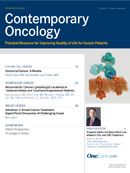Publication
Article
Progress Made, but More Work Lies Ahead in CLL and CRC Treatment
Author(s):
A look at the benefits of the chemoimmunotherapy rituximab for CLL and a look at the treatments and advances made in treating metastatic CRC.

Andre Goy, MD, MS
Editor-in-ChiefContemporary Oncology Chief, Lymphoma Division, Professor and Chairman John Theurer Cancer Center at Hackensack University Medical Center
This article offers highlights from some of the advances we’ve seen in hematological and solid tumors over the past 2 decades. The first report by Janssens and colleagues focuses on the changes in chronic lymphocytic leukemia (CLL) outcomes and the benefits of chemoimmunotherapy, namely rituximab, using a meta-analysis to compare regimens used in the United States and Europe. The second paper by Popek and Tsikitis reviews the broad changes that have occurred in the treatment and management of metastatic colon cancer.
CLL is the most common form of leukemia and the second most common blood cancer after lymphomas. CLL has long been regarded as an incurable disease of the elderly, treated mainly by symptom palliation. While some patients can have a very indolent course (ie, never require treatment and have the same life expectancy as normal control groups), others can have a much more rapid course. In some cases, the disease can even transform into large cell lymphoma (eg, Richter syndrome). Prior generations of chemotherapy resulted in improved response rates but did not change the natural history of the disease. However, prolonged remissions and improvements in survival are now possible, owing to therapeutic advances in the use of purine analogs as frontline treatment and the emergence of monoclonal antibody-containing chemoimmunotherapy combinations.
As is the case with indolent non-Hodgkin lymphoma (NHL), clinical criteria have been developed to help determine when to initiate therapy in patients with CLL. However, the criteria are somewhat subjective and tend to lead to heterogeneous treatment, which might affect comparisons from one trial to another. Moreover, as in indolent NHL, using overall survival (OS) as an endpoint can be a challenge due to the long natural history of the disease. Therefore, surrogate markers of outcome, such as overall response rate (ORR), complete response rate (CRR), and progression-free survival (PFS), have often been used. Over the past 3 decades, trials have looked at a number of regimens—from chlorambucil single agent to purine analogs (fludarabine and to a lesser degree pentostatin) to combinations with fludarabine and cyclophosphamide (FC)—based on significant synergistic cytotoxicity in preclinical models. Combination FC was shown to be superior to fludarabine alone, and fludarabine/cyclophosphamide/rituximab (FCR), which was developed at MD Anderson Cancer Center, has been shown to be superior by all parameters (ie, ORR, CRR, duration of response [DOR], and PFS).
Rituximab, a chimeric anti-CD20 monoclonal antibody that targets the cell-surface antigen CD20 expressed on more than 90% of mature B-cell malignancies, has proven to be a game changer in B-cell NHL. However, rituximab has limited single-agent activity in CLL (ORR 12% at 375 mg/m2) which may be attributed in part to the reduced tumor expression of CD20 and the presence of soluble CD20 serving as a decoy receptor in CLL.
The addition of rituximab to FC (ie, FCR) doubles the proportion of patients entering complete remission, and significantly prolongs remission duration and OS. The quality of the responses has led to the emergence of minimal residual disease (MRD), and patients with no MRD had the best outcome. Strategies of consolidation and maintenance therapies have been developed for patients to reach negative MRD. This includes more rituximab or better alemtuzumab, an anti-CD52 antibody. Unfortunately, FCR is not always a treatment option (eg, in elderly, “nonfit” patients), and patients with poor risk factors, especially those with p53 abnormalities (mutation/deletion), still have a poor outcome. Ongoing studies are looking at FCR plus alemtuzumab in these patients, but issues related to toxicity, myelosuppression, and immunosuppression (especially infection, pneumocystis pneumonia, and cytomegalovirus reactivation) are an obvious concern with this combination regimen.
In the relapse setting, an increasing number of patients are fludarabine-resistant and represent a clear challenge to the clinician. A growing list of new salvage options has been developed, again showing a benefit from the combination with rituximab. Not surprisingly, some of these new options are being implemented in the frontline setting as well. Bendamustine, approved in relapsed CLL, is now being tested in the frontline setting in the CLL10 trial (bendamustine/rituximub vs FCR). Results of this trial are still pending. In addition, a number of new monoclonal antibodies have been developed or are currently in development for the treatment of CLL. For example, ofatumumab, which targets another epitope of CD20 and induces greater complement-dependent cytotoxicity, has shown activity in CLL double failures (fludarabine and alemtuzumab).
Also, based on its promising activity in the relapsed setting, the immunomodulator lenalidomide is now being tested as maintenance and consolidation postinduction therapy or as new backbone for a nonchemotherapy option in elderly patients in the frontline setting. Finally, small molecules targeting the BCR pathway (ie, phosphoinositide-3 kinase inhibitor and Bruton’s tyrosine kinase inhibitor) have recently shown impressive activity in phase I and early phase II studies, even in patients with poor molecular risk subtypes. Remarkably, CAL1010 and PCI3275 showed a very favorable toxicity profile, offering a great opportunity to build upon the success of chemoimmunotherapy in CLL in a variety of combinations.
The article by Popek and Tsikitis reviews new strategies for the diagnosis and treatment of colon cancer. Although significant advancements have been made, colorectal cancer (CRC) is still a common and lethal disease. Approximately 142,570 new cases of large-bowel cancer are diagnosed each year in the United States—about two-thirds are colon cancers and one-third are rectal cancers. Although mortality has been progressively declining since the early 1990s, CRC remains the second most common cause of cancer deaths.
The majority of CRCs are sporadic and have modifiable risk factors that can be managed through diet, weight loss, and elimination of tobacco use. A small number of CRCs are familial cases that shed great light on the multistep oncogenic pathways of colon cancer, while chronic inflammatory bowel disease is considered the third player in CRC pathogenesis.
Most CRCs are adenocarcinomas and are typically diagnosed by colonoscopy. A variety of serum markers have been associated with CRC, particularly carcinoembryonic antigen (CEA) and carbohydrate antigen 19-9 (CA-19.9), but they both have a low diagnostic ability to detect primary CRC due to a significant overlap with benign disease and a low sensitivity for early-stage disease. Despite the large number of correlative studies exploring the prognostic significance of various histologic, molecular, and clinical features, the pathologic stage at diagnosis remains the best indicator of long-term outcome in CRC, especially the presence of distant metastases, local tumor extent, number of involved lymph nodes, and residual disease postsurgery. A number of prognostic tests, including routine use of p53, thymidine synthase, dihydropyrimidine dehydrogenase, thymidine phosphorylase, IL-8, VGEF, CXCR2, microsatellite instability, 18q loss of heterozygosity, or testing for DNA mismatch repair genes, have been developed to stratify CRC patients, but none of these tools have translated into changes in the management of CRC patients.
Surgery plays a critical role in the staging and treatment of CRC. In fact, we now have enough data to support when it is feasible to use laparoscopic approaches that produce no difference in relapse rate or outcome compared to standard surgery. The role of adjuvant therapy is well-established, at least for stage III/IV disease, and has truly impacted both PFS and OS. On the other hand, the majority of patients with metastatic colorectal cancer (mCRC) cannot be cured. Although a subset of patients with liver and/or lung-isolated disease are potentially curable with surgery, most patients receive palliative treatment and systemic chemotherapy.
For decades, 5-fluorouracil (5-FU) was the sole active agent, but this has changed markedly since the mid-1990s with the approval of 3 new cytotoxic drugs and 3 new humanized monoclonal antibodies. The 3 new cytotoxic agents are capecitabine (an oral fluoropyrimidine), irinotecan (a topoisomerase I inhibitor that blocks DNA repair), and oxaliplatin (an inhibitor of DNA replication and possibly a down-regulator of the expression of thymidylate synthase). The 3 new humanized monoclonal antibodies target either VEGF (bevacizumab) or EGFR (cetuximab and panitumumab). Benefit from monoclonal antibodies targeting the EGFR is restricted to patients whose tumors do not contain mutated KRAS (ie, KRAS wild-type).
A number of combinations and schedules of these available agents have been studied, and although the best combination, sequence, or duration of treatment are not firmly established, systemic adjuvant chemotherapy can produce meaningful improvements in median survival and PFS. These benefits are most pronounced with regimens containing irinotecan or oxaliplatin in combination with 5-FU; this led to median survival ranges >2 years versus 5 to 6 months for best supportive care alone. In addition, combination chemotherapy in the neoadjuvant setting can be helpful for patients whose metastases (especially to the liver) might then become potentially resectable after initial chemotherapy response. The use of bevacizumab is still debated, especially regarding the continuation of its use or after disease progression using a regimen containing bevacizumab. Given the lack of data from randomized trials, cost of the drug, and potential toxicity issues, the addition of bevacizumab after progression (ie, second- or third-line) cannot be considered a standard approach outside of a clinical trial, but could be considered in select patients, specifically in those with KRAS-mutated tumors where anti-EGFR therapies are not indicated.
Finally, screening plays a major role in the early diagnosis of colon cancer. There are several screening methods, including occult fecal blood detection, computed tomographic colonography (CTC), sigmoidoscopy, or colonoscopy. However, given the lack of randomized trials to demonstrate that a reduction in mortality from CRC is associated with the performance of colonoscopy or CTC, there is still an ongoing debate on the actual benefits of screening. The results of large ongoing trials in both Europe and the United States might help develop better recommendations, but strategies that include risk stratification for colorectal cancer screening are still needed.
Although the outcomes of advanced CRC or mCRC have improved over the past decade, the results are continue to be disappointing. Unfortunately, there is still frequent chemoresistance, and no perfect model exists to integrate conventional and targeted agents. To further complicate matters, these new targeted agents have their own issues of toxicity and have dramatically increased the cost of care.
Despite the advances in treatment for both CLL and CRC, more work needs to be done to develop novel therapies and a rationale for new drug combinations using reliable clinical tests. These efforts will help guide us towards individualizing therapy and will ultimately help us improve outcomes for our patients.










